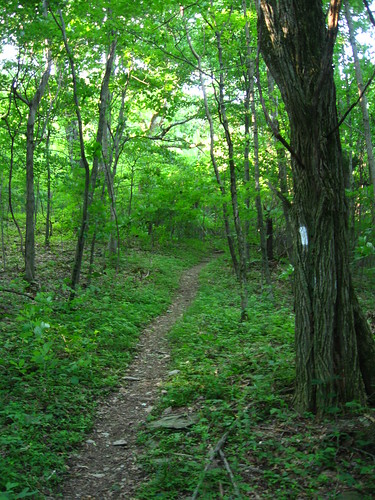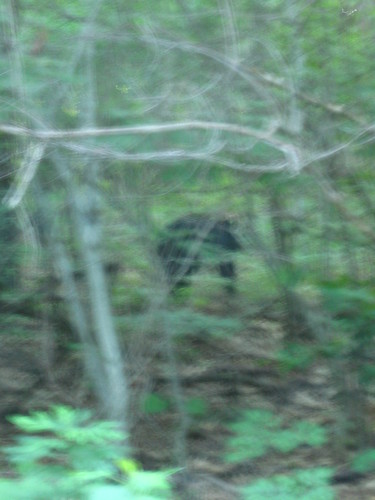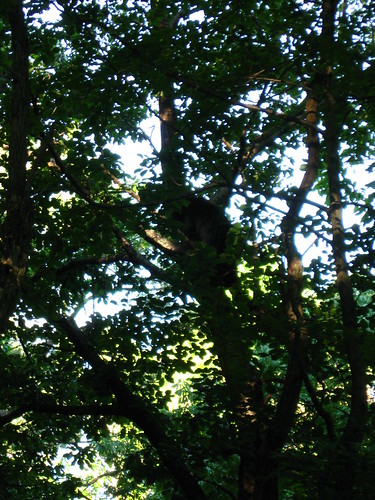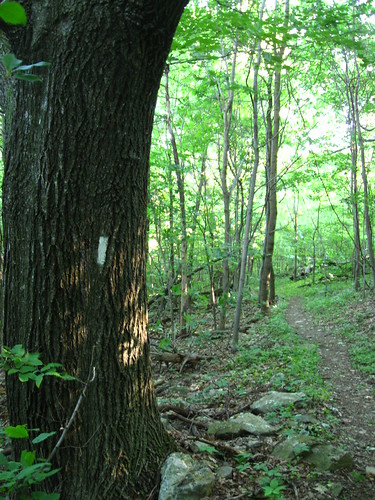
The AT at Jarman's Gap.

Black bear walking through the woods.
This morning before work I headed up to Jarman's Gap in Shenandoah National Park for an early morning walk. I soon found myself stalking a bear. I noticed the bear walking across the Skyline Drive at a distance as I approached mile marker 97 and realized I could probably get a good look by walking back on the AT from the gap.
The bear was walking slowly in the forest as I walked as silently as I could, hoping to get a better look. I walked along the trail and listened for the sound of the bear breaking twigs in the forest. All was silent. I decided to backtrack and heard something dropping from a tree, or at least I thought I did.
Walking under a medium sized cherry all was quiet. "Must have been a squirrel," I thought. After I passed under the cherry, rustling from the tree caught my attention. There was the bear! High in the tree. I had just walked right under it!
The bear hastened down the side of the tree away from view and scrambled into the deep woods. That was the last I saw of it.

The bear, who I had just walked right under!

The trail, quiet in the early morning light.

Honeysuckle.
That seems like kind of a risky thing to do. Glad you're OK.
ReplyDeleteI guess its time for the Don't Try This at Home disclaimer.
ReplyDeleteI do enjoy seeing wild animals. Over the years I've seen quite a few deer, a number of bear and one coyote while hiking. All wild animals should be treated with respect regardless of their size. Would you believe me when I tell you that the animal that freaked me out the most was a large buck who refused to give way on the AT. He stood still, pawed and blew. I walked around him in a very wide circle.
With that in mind; 'stalking' NEVER means invading the animal's space. It does mean attempting to obtain an unobstructed view from a safe distance.
A Mother bear with cubs needs special respect. Cubs can easily veer off course, leaving you between Mother and Baby. That is to be avoided. The ideal spot for watching bear families is a high bluff overlooking the creek they're resting by.
If the bear notices you you are too close. Avoid eye contact and move back the way you came. Don't run and don't drop down suddenly as these actions on your part can trigger an animal to respond.
Bears naturally avoid humans but lately some have begun to associate people with food. This can lead to unpleasant interaction between man and bear. If a bear goes after your pack food, you can yell and bang pans together. Some AT hikers report having thrown rocks at bears [not a good idea unless you are actually being attacked, and from all reports, it doesn't work all that well anyway]. Get used to the idea that you will drop your pack and let the bear have it if necessary.
It goes without saying that you should not feed wild animals or provoke them. Feeding can easily become provoking when you decide to keep the rest for yourself and close the bag. Every year the game department spends a lot of time and money relocating bears who get too used to being around humans. The problem is that bears can find their way back. Bears that go this route generally end up dead.
If you want to observe wild animals you should learn their ways, know their strength and keep a healthy distance.
It's sad when an animal does have to be killed because people have make food available to them. Wild is wild and I have a healthy respect for wildlife. We did see bison and elk quite a bit in the past (out west) but always gave them plenty of room. It always amazed me to see people get within 5-10 feet of a bison to take pictures. We used it as a teachable moment with the boys. As they say, you can't outrun most wild animals.
ReplyDelete